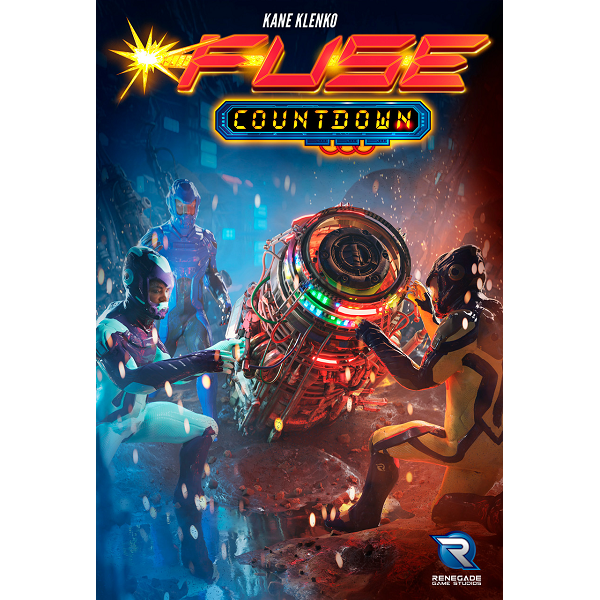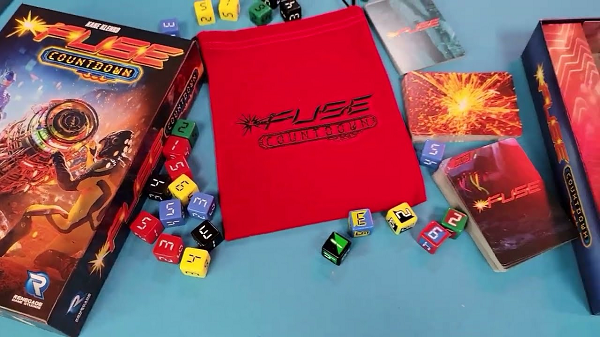Communicate, Concentrate, and Cooperate to Defuse Bombs in FUSE Countdown

Pull dice, roll them, and divvy them out to everyone to defuse the bombs. Defuse enough bombs before the time runs out to save the ship and crew.
Published by Renegade Game Studios for 1-4 players, FUSE Countdown is a standalone expansion for their real-time cooperative game FUSE.
Gameplay
Each player is dealt a character card which comes with a unique character ability. Each player is also dealt two bomb cards, which they place face-up in front of themselves. Five cards are dealt face-up into a display and the rest of the bomb deck is placed next to it.
A ten-minute timer is started and the game begins. The active player draws dice from the bag equal to the number of players. Only the active player can use his character ability during a turn. The active player then rolls the dice. The dice come in different colors. Some dice are two colors and players can choose which color to use.
Each player must then select one and only one die and place it legally on any of his bomb or spark cards. Once a die is placed, it cannot be removed until that card is completed. Each bomb card has a different number of spaces, with each space showing what requirements are needed in order to place a die on it. For example, two spaces on a card might require two dice of specific numbers, while the other two spaces might ask for another two dice whose colors match each other. Some cards will also ask you to make a tower of dice, stacking them on top of each other, with specific dice required at each level of the tower. Some cards can also list certain dice that cannot be used to complete the card.
If a player is unable to legally place a die, then he must draw a spark card. These, like bomb cards, require specific dice to fill its spaces. Once all the spaces on a bomb or spark card are filled, the card is discarded. For bomb cards, you then select a new card from the display, and draw a new one from the deck to replace it. It is now the next player’s turn to be the active player.
Players win the game if there are no spark cards in front of anyone, and no bomb cards in the display or draw deck (players do not have to complete all bomb cards in front of themselves) before the timer runs out. They lose the game if the timer runs out and they have not completed those conditions or, if at the start of a turn, there are no dice in the dice bag.
There are additional fuse cards that you can shuffle into the bomb deck to increase difficulty. When one of these is drawn you must take the penalty shown before discarding it and drawing a new bomb card for the display. These penalties often force you to discard dice from your bomb cards, but they can also trigger other actions such as forcing everyone to draw a spark card.

Image source: publisher unboxing video for FUSE Countdown
Review
FUSE Countdown is a little less chaotic than other cooperative real-time games out there, as there are distinct turns and ten minutes can be longer than you think, but you are still trying to make snap decisions, communicate quickly and deal with the fallout for the inevitable mistakes that crop up as a result.
You are trying to figure out where dice would be best allocated, with the constraint that everyone needs to take one and only one die, which can be challenging given the luck of the draw, all while not wasting time. This leads to a great give-and-take with excellent player interaction.
Some of the iconography can be confusing, which leads you to pause the timer to check the reference on the back of the rules when you’re first starting to learn the game. The symbol to show you that a specific color of die is not allowed on a card is especially confusing, as it’s quite small and not where you’d expect it on the card. Also, the colors on it can be hard to distinguish.
The sparks, split dice, and player abilities add enough to justify adding the game to your collection even if you already own FUSE. However, FUSE itself is a little easier to teach and learn, so if you're only looking to own one it's going to depend on the complexity you're after.
We quite enjoyed our time with FUSE Countdown. It adds some fun twists onto some already enjoyable gameplay, and it’s always fun to revisit FUSE.
Pros: Adds new ideas to FUSE, solid player interaction
Cons: Iconography could be improved
Disclosure: we received a complimentary review copy of this game.







